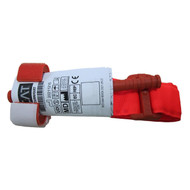Tourniquets: A Lifesaving Tool You Should Know About
Posted by DS Medical on 4th Sep 2023
Introduction
In emergencies, every second counts, and having the right tools can make the difference between life and death. One such tool that has been a crucial lifesaver in various situations is the tourniquet. While tourniquets have been in existence for centuries, their importance in modern first aid and emergency response cannot be overstated. In this blog post, we will explore what tourniquets are, how they work when to use them, and some best practices for their application.
What is a Tourniquet?
A tourniquet is a medical device designed to stop the flow of blood through a limb by constricting the blood vessels. It typically consists of a strap or band that is tightly wrapped around the limb, and a windlass or a tightening mechanism to apply pressure. Tourniquets are primarily used to control severe bleeding in emergency situations, such as traumatic injuries or accidents.
How Tourniquets Work
Tourniquets work by applying pressure to the limb, which compresses the blood vessels, thus stopping the flow of blood. The goal is to halt bleeding from severe wounds until professional medical assistance can be obtained. It's important to note that tourniquets should only be used as a last resort when other methods of controlling bleeding, such as direct pressure and wound packing, have failed or are not feasible.
When to Use a Tourniquet
Using a tourniquet is not a decision to be taken lightly, as improper or unnecessary use can lead to complications. Tourniquets are typically reserved for situations involving life-threatening bleeding that cannot be controlled by other means. Here are some scenarios where a tourniquet might be appropriate:
- Severe limb trauma: When there is a severe injury to an arm or leg, such as a gunshot wound, deep laceration, or amputation, and bleeding cannot be controlled with direct pressure.
- Mass casualty incidents: In situations where there are multiple casualties and limited resources, a tourniquet may be used to quickly stabilise a wounded individual and move on to the next patient.
- Prolonged rescue time: In remote or hostile environments where access to medical care is delayed, a tourniquet can be used to buy time until professional help arrives.
Best Practices for Tourniquet Application
When using a tourniquet, it's crucial to follow best practices to minimise the risk of complications. Here are some key guidelines:
- Tourniquet placement: Apply the tourniquet as high on the limb as possible, between the wound and the body's trunk.
- Avoid joints: Do not place the tourniquet directly over a joint, as it may be less effective in controlling bleeding.
- Tighten until the bleeding stops: Use the windlass or tightening mechanism to apply enough pressure to stop the bleeding. Do not overtighten, as this can cause additional damage.
- Note the time: Always record the time when the tourniquet was applied. Tourniquets should not be left on for extended periods, as this can lead to complications.
- Monitor the patient: Continuously assess the patient's condition and release the tourniquet as soon as professional medical help is available.
Conclusion
Tourniquets are invaluable tools in emergency situations where severe bleeding poses a threat to life. Knowing how and when to use them correctly can make a significant difference in saving lives. However, it's essential to remember that tourniquets are not a substitute for professional medical care, and their use should be a last resort. Proper training in tourniquet application and first aid is essential for anyone who may find themselves in situations where this lifesaving tool is needed.


